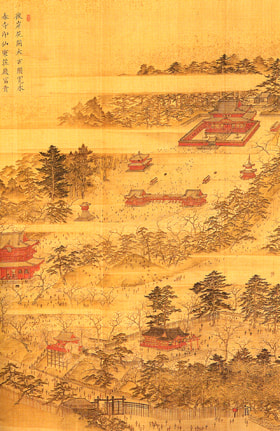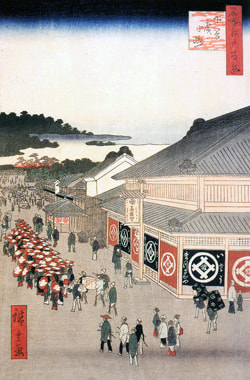
Hiroshige Utagawa "Meisho Edo-hyakkei - Shitaya Hirokoji," or Notable Site, Hundred Views of Edo - Shitaya Hirokoji
Large merchant houses line the street in Shitaya, a temple town of Kan-eiji. It is as if a bustle of people in the area around Shitaya Hirokoji (present-day Ueno Hirokoji) can be herd.
Q: When I see Shinobazu-no Ike Pond, I feel that it was made as Mitate. There is also Mitate of Kiyomizu-dera Temple's stage. I think that the area was developed as a pleasure resort.
Urai: Well, regardless of whether the term "pleasure resort" is appropriate or not, it is sure that Tenkai intended to create such a place. He might think that, in addition to shogunate's official temple facilities, entertaining facilities were needed. He wanted to create an enjoyable place where commoners could visit anytime. It might be called "pleasure resort" in modern-day language. In order to create such a place, it was necessary to move "Nadokoro," or notable sites, in Yamashiro and Omi into Ueno. In other words, he brought Nadokoro in Yamashiro and Omi, on which Mount Hiei is situated, to Ueno. Therefore, he created Mitate of the great statue of Buddha at Hokoji Temple in Kyoto, and placed it at the site that you can see now. Gion-do was also built at the site where Seiyo-ken stands now, welcoming Gion, a deity, from Yasaka Shrine.
Q: Did a variety of Buddha and Shinto gods coexist?
Yes. They coexisted. Now we can go to Kyoto in just two and a half hours, but, at that time, it took about 15 days or 12 days if you hurried. Also, the shogunate did not easily permit commoners to go to Kyoto. It was the late Edo Period when commoners began to go to Konpiragu Shrine or Isejingu Shrine. However, at that time, it was impossible for commoners to visit Kyoto without the shogunate's permission taking 15 days off. They could not visit Kyoto. They only heard about Kyoto. The following is my thought; Tenkai's idea was that if he gathered miniatures and reproductions (of buildings in Kyoto) in Edo, commoners went to Ueno and could feel as if they visited Kyoto.
Q: has this site become a notable site because of that?
So Ueno rapidly became notable sites equal to Asakusa because of that. To Tenkai's credit, he not only made Mitate of buildings in Kyoto but also conducted environmental arrangements. He planted Yoshino cherry trees in Ueno. He turned Shinobazu-no Ike Pond into a ceremonial release pond, and planted red and white lotuses in the pond. Japanese maples were also planted along a street (The International Library of Children's Literature is now located along the street). Therefore, that place was called "Nishiki-koji," or colorful street, in the Edo Period.
Q: How were the cherry blossoms at that time?
Following Tenkai's idea, the cherry trees were planted. Razan Hayashi, who established his private school at the site where the statue of Takamori Saigo stands now, sympathized with Tenkai, and planted cherry trees around his school. Cherry trees in other area were planed by Tenkai.
Q: Had Ueno already been a cherry blossom viewing spot?
Tenkai and Razan Hayashi turned Ueno into a cherry blossom viewing spot. Tenkai also planted winter camellias and Japanese red pines around an area where the fountain is now placed. I think Tenkai intended to create a place where commoners could visit in any season. They could see cherry blossoms in spring, lotus flowers in summer, colored leaves in autumn, and winter camellias and plum blossoms in winter. I think Tenkai attempted to turn the shogunate's prayer temple into a kind of popular place where commoners could freely visit, or so to speak, a noted place.(continued in the right column)
That explains the reason why an unseasoned wood was used for Kiyomizu-do's "ushibari," or the largest beam, which was unveiled during the temple's dismantling and repair. Additionally, a various kind of woods were used. Generally, a building of such scale is built with Japanese cypress or Japanese zelkova.
Q: So it was built in a hurry?
There is a record indicating that Tenkai built the temple at his own expense. There were not enough funds. Hidetada Tokugawa decided to build Kan-eiji Temple, and the temple was established during Iemitsu's rule. However, Iemitsu did not build just one building in the temple grounds. It was not until the reigns of Ietsuna and Tsunayoshi that other buildings were built. The reason why those buildings were not built until their reigns was that Tenkai carried out various things that were against the shogunate's policy.

Gyokuransai Sadahide Hashimoto "Toeizan-zu," or image of Toeizan (portion, owned by Kan-eiji Temple)
Q: The history is that an Imperial Prince became the third chief priest.
The first chief priest was Tenkai, and Kokai, a son of Tadanaga Kazanin, became the second chief priest. Tenkai wanted to have an Imperial Prince as the third chief priest, but it was not realized in his lifetime. However, Shucho-hosshino, the third son of Emperor Go-Mizunoo, was apprenticed to Kokai, and became the third chief priest of Kan-eiji Temple in 1654. Since then, sons or adopted sons of Emperors successively took the position - from the third chief priest to the fifteenth chief priest.
Q: Does this practice still continue?
It does not continue. After Kitashirakawa-no-miya Yoshihisa-shinno, who perished in the war in Taiwan, was forcibly returned to secular life by the Government in 1868, no Imperial Prince took the chief priest's position.
Q: I have heard that the Imperial crest of the chrysanthemum is attached to Rinnoji Temple.
The reason is that an Imperial Prince became the chief priest of Rinnoji Temple.(continued in the next page)

Hiroshige Utagawa "Meisho Edo-hyakkei - Shitaya Hirokoji," or Notable Site, Hundred Views of Edo - Shitaya Hirokoji
Large merchant houses line the street in Shitaya, a temple town of Kan-eiji. It is as if a bustle of people in the area around Shitaya Hirokoji (present-day Ueno Hirokoji) can be herd.














